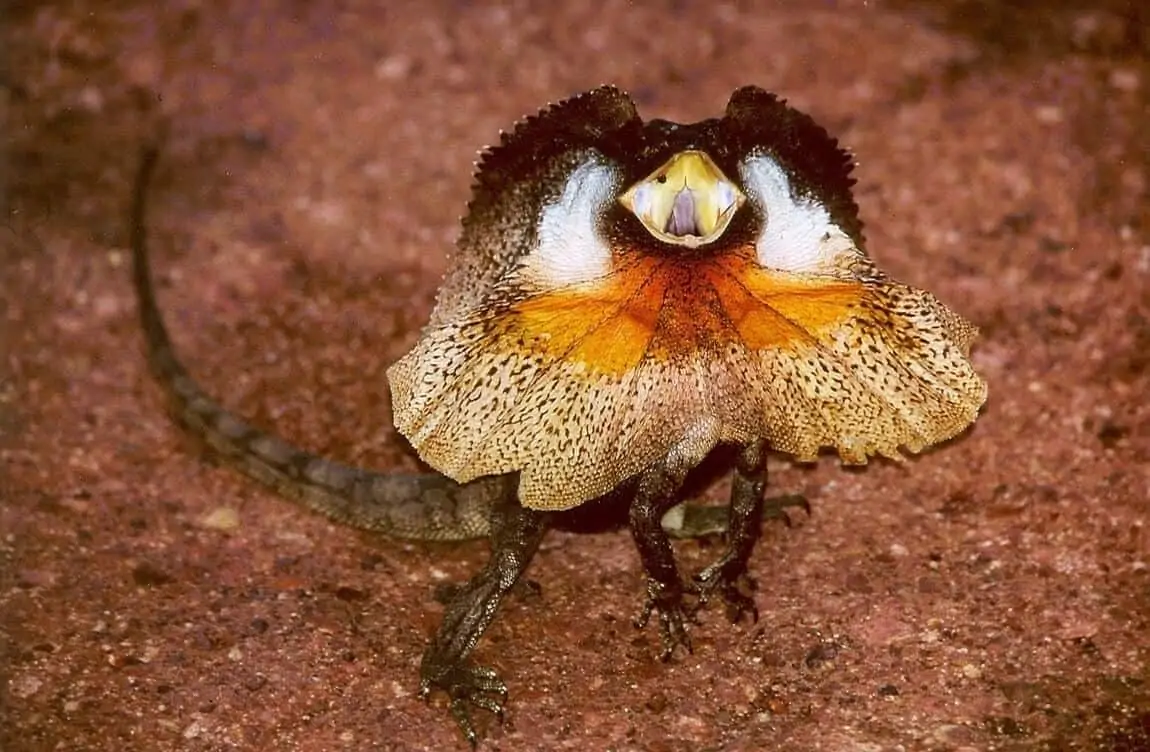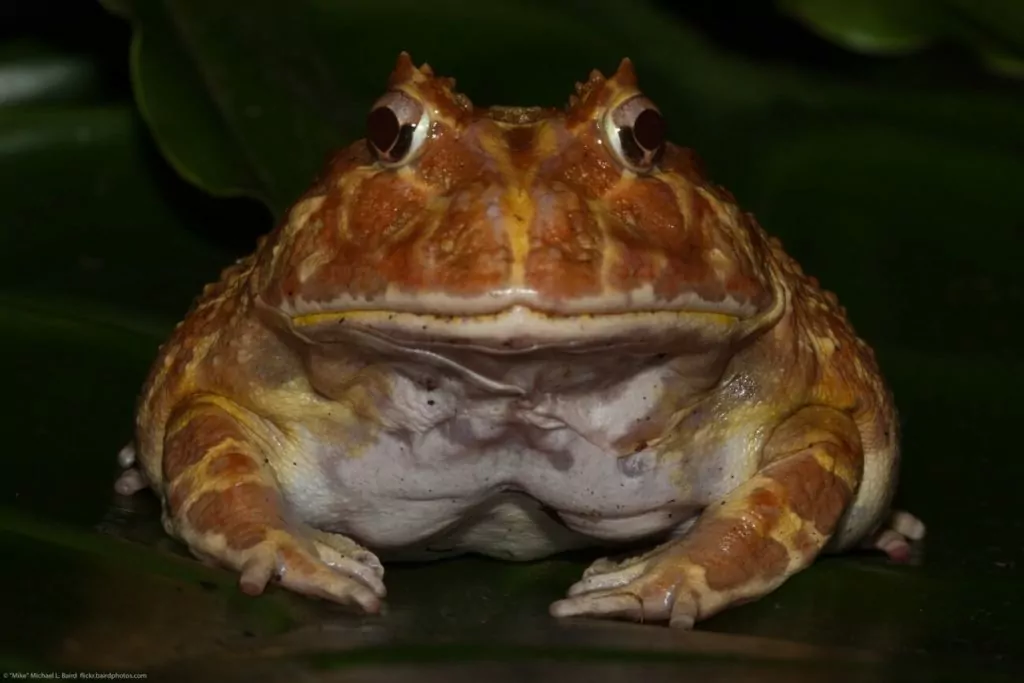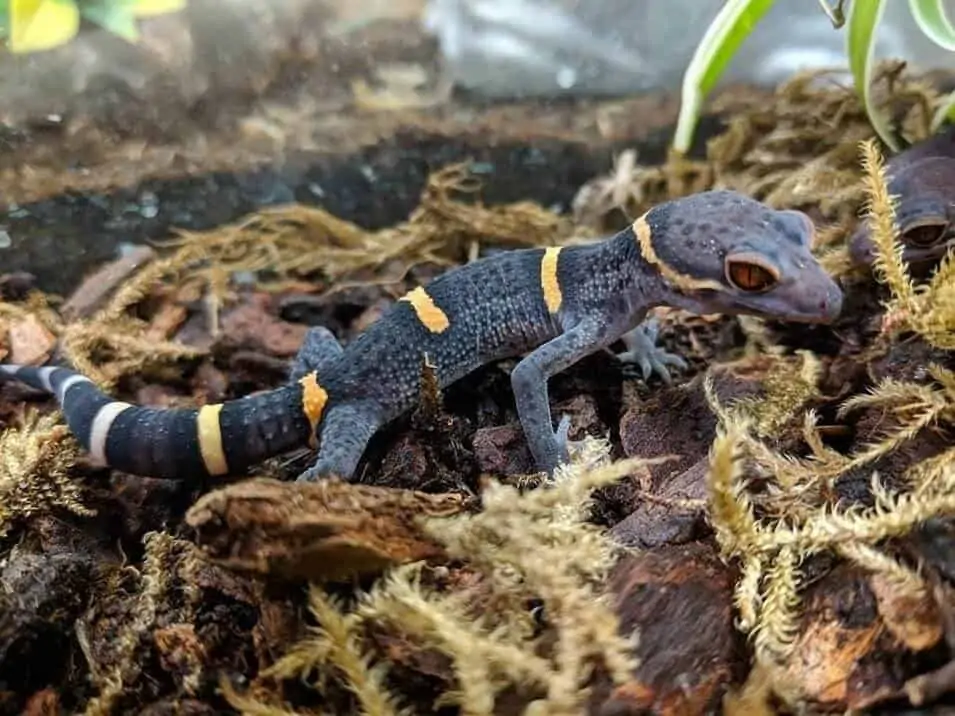Frilled dragons are an incredibly interesting reptile that has grown in popularity over the last handful of years. To be honest, they’re one of our all-time favorites!
Not only do these lizards have a unique look, but they’re also quite personable. They’re one of the most enjoyable species you can own.
And on top of that, they’re pretty low-maintenance. Caring for them won’t be a challenge as long as you know what to expect and stay consistent.
This guide will teach you the fundamentals of frilled dragon care. You’ll learn about their diet, enclosure setup, temperament, size, and more!
Table of Contents
Species Summary
The frilled dragon (Chlamydosaurus kingii) is a unique pet with some standout physical features.
While they were discovered almost 200 years ago, the frilled dragon only recently became a hot commodity in the reptile trade. So thanks to a certain blockbuster dinosaur movie (take a guess which one), these popular pet lizards are in high demand!
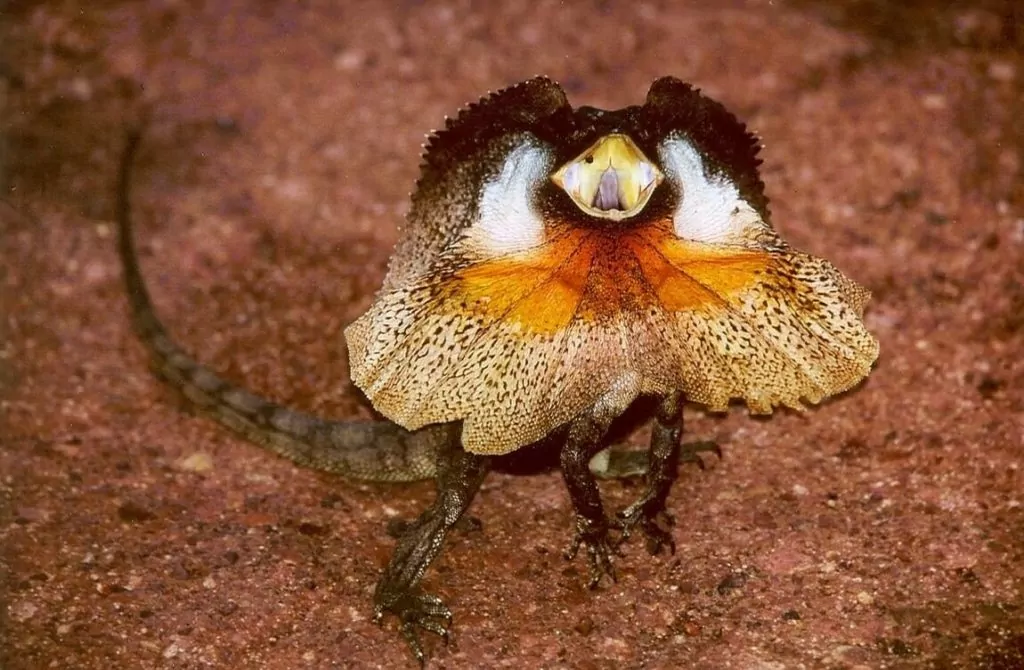
This reptile is endemic to Northern Australia and Southern New Guinea. Lizards from these two distinct areas are biologically similar. However, frilled dragons have unique appearances based on where they come from.
Despite their reputation in popular media, frilled dragonns can be quite docile. They develop strong bonds with owners, making them a joy to raise in captivity.
Average Frilled Dragon Size
The maximum adult frilled dragon size is around 36 inches in length.
Expert Tip: Generally, lizards from Australia are larger than those from New Guinea. If your lizard comes from New Guinea, a length of approximately 26 inches when fully grown is a more reasonable expectation.
Regardless of where the lizard came from, males tend to be bigger than the females. Female frilled dragons are roughly a third smaller than males.
Lifespan
The typical frilled dragon lifespan is between 10 and 15 years. This is more than enough time to build a really strong bond!
This lizard species does have some unique care requirements. Failing to address their needs could lead to stress, disease, and a much shorter lifespan.
Appearance & Colors
By far, the most identifying feature of the frilled dragon is the “frill.” This is the skin flap surrounding the head. When calm and peaceful, these skin flaps lie flat against the lizard’s body.
But the moment the lizard feels threatened, they’ll raise the frill. This is a unique defense mechanism that makes the lizard look far bigger than it really is! Oftentimes, the frill has brighter coloration than the rest of the body. As a result, this raised skin is very intimidating to would-be predators.
The rest of the body is relatively muted. You may see colors of grey or brown. Dark splotches of color cover the entire body, creating a mottled pattern.
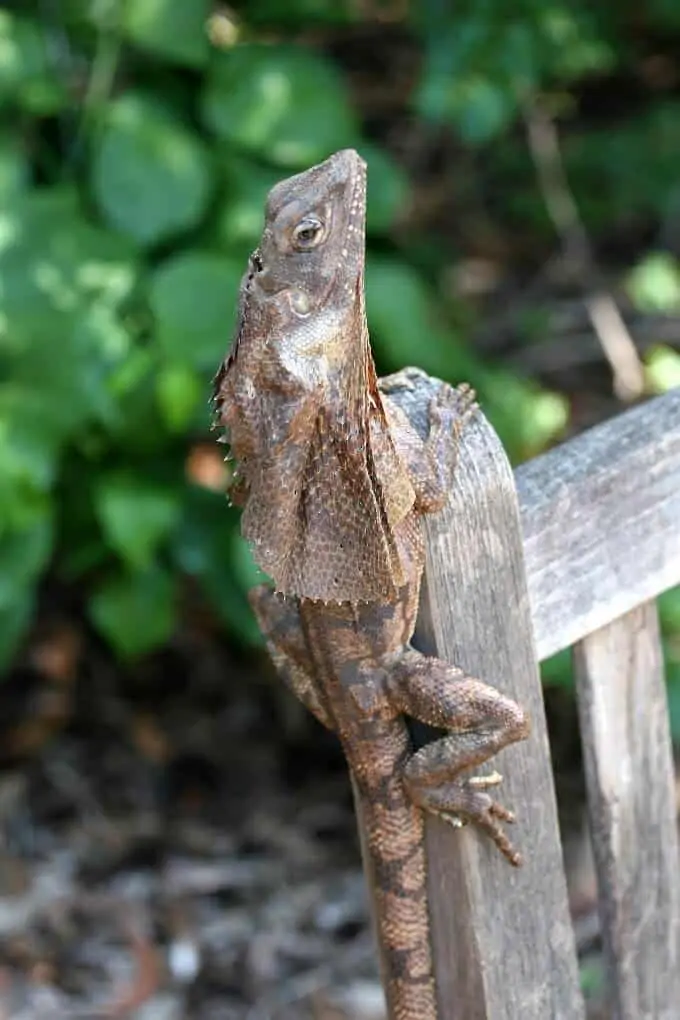
The cool thing about frilled dragons is that coloration can vary based on where the lizard came from. These lizards are natural camouflage artists
So, those coming from heavily wooded areas have colors that are more reminiscent of tree bark. On the other hand, specimens coming from dry clay-filled lands tend to have colors of orange and red.
The tail of the frilled dragon is very long. It’s used to provide balance when climbing. Typically, the tail will account for about two-thirds of the lizard’s entire length!
There are some physical differences between males and females. Like we mentioned earlier, males are larger than females. Beyond that, the frills are larger, too. Females usually have plumper abdomens as well.
Frilled Dragon Care
Frilled dragon care isn’t as difficult as it might seem. These unique creatures actually do quite well in captivity!
As long as you’re providing a healthy diet and a well-maintained environment, these intelligent reptiles can thrive as pets under your care! Here are some tips and essential guidelines for you to follow.
Enclosure Size
Because frilled dragons can get pretty large, you’re not going to be able to keep them in a standard reptile tank or cage. These lizards require a lot of room to explore. Plus, you must have an enclosure that’s large enough to effectively manage temperature and humidity levels (more on that later).
A frilled dragon enclosure for a single adult needs to be at least 36 inches long, 24 inches wide, and 48 inches tall. That will cover their basic needs.
However, we always recommend going a bit larger if you can.
Ideally, their enclosure will measure around 48 inches long, 30 inches wide, and 60 inches tall. This size is great for either a single lizard or a bonded pair.
Expert Tip: The enclosure should have solid sides. Wood, glass, or acrylic will do fine. The latter two options are preferred so that you can see what your lizard is up to!
On top of the enclosure, go for metal screen or firm mesh. This will help keep the space ventilated.
Habitat Setup
You have a lot of options when it comes to their decor and habitat setup. These lizards come from a wide range of environments, so they’re pretty easy to please!
Because frilled dragons are arboreal, the most important things you’ll need are climbable items.
Take advantage of climbing branches and vines. Arrange them so that they’re not too close together! Branches that touch could end up pinching your lizard’s toes or tail.
Make a nice network of branches so that your lizard has plenty of ways to get comfortable.
On the bottom of the enclosure, place a couple of inches of substrate. You can keep things simple with reptile bark mulch. Or, you can use things like coconut fiber, a mixture of soil and play sand, or cypress mulch.
Expert Tip: Choose a substrate material that can hold onto moisture. The material should release moisture into the air throughout the day so that you can easily maintain humidity levels.
Some forms of shelter are preferred as well. Use natural rocks, large pieces of cork wood, or even artificial caves to give your lizard some retreat from the light. Live or artificial plants work well, too.
Temperature & Lighting
Proper temperatures and lighting are crucial for frilled dragons. These are sun-loving lizards that need high temperatures to truly thrive. Like many other reptiles, your goal for the enclosure should be to create a temperature gradient.
- On one end of the enclosure, create a basking spot that reaches temperatures as high as 115°F.
- On the opposite side, ambient temperatures should be in the upper 80s to lower 90s.
Frilled dragons will move to different parts of the enclosure to regulate their temperature throughout the day.
At night, temperatures can drop as low as 75 degrees. If things get lower than that, consider using a heat mat or heat emitter.
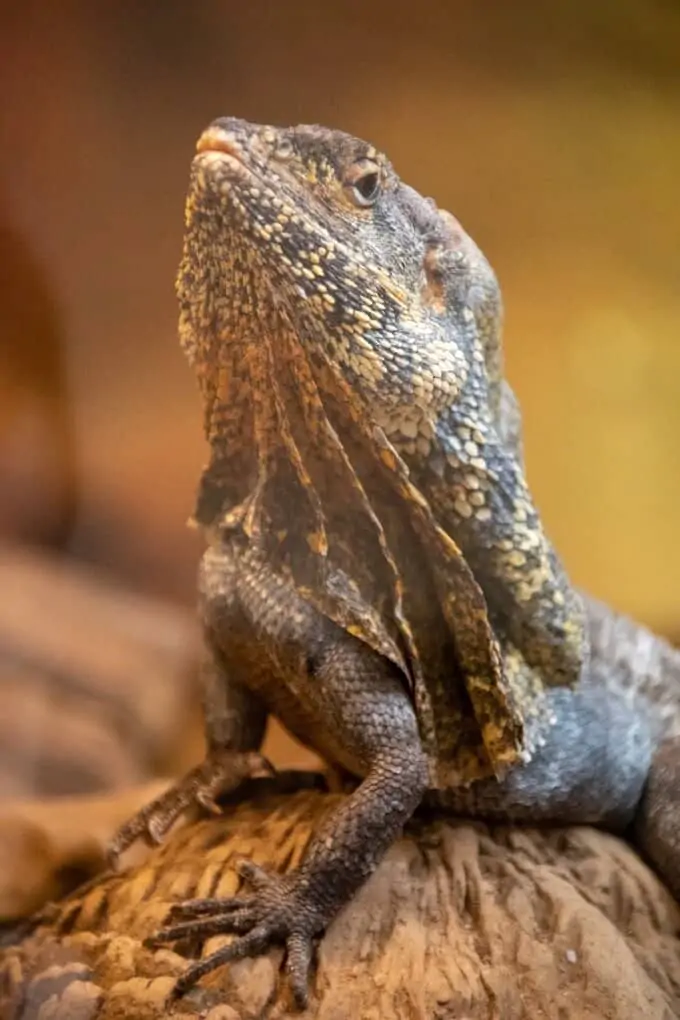
In addition to standard lighting, you’ll need UVB lamps. UVB lamps are important because they help your lizard’s body effectively metabolize calcium. Shine a UVB lamp into the enclosure for about 14 hours a day. It should be the same time your other lights are on to create a standard day/night cycle.
Humidity
Frilled dragons use humidity in the air to stay hydrated. Because of this, it’s important for you to maintain humidity levels around the clock.
In the lizard’s enclosure, humidity levels between 50 and 70 percent are best. Use a hygrometer to stay within this range.
To raise the humidity, mist the enclosure once a day. The substrate and any plants in the environment will help hold onto moisture.
If you need to lower it, open up the top of the habitat to improve air circulation. Do this briefly, check the humidity again, and repeat as needed.
Water
Having a water dish in your pet’s home serves a few different purposes. While frilled dragons may use it to drink from, this behavior is actually quite rare.
Instead, these reptiles use a water dish primarily for soaking and temperature regulation. Add a dish that’s large enough for your dragon to get into.
It’s always important to keep an eye on water quality. These reptiles may sour the water quickly by defecating in the dish. When this happens, clean it out and replenish the water supply as soon as possible.
Food & Diet
Frilled dragons are omnivores that eat insects as their main diet staple. In the wild, these lizards have a lot of variety in their diet. So, it’s important to replicate that lifestyle by providing several different foods.
You can feed your frilled dragons a diet of:
- Brown crickets
- Locusts
- Waxworms
- Cockroaches
- Mealworms
- Beetle grubs
- Grasshoppers
- Caterpillars
- Light fruits
- Green vegetables
If you are providing insects, make sure to gut-load them first. Also, dust them with calcium powder and Vitamin D3 supplement powder every other feeding.
Juveniles need to eat daily to satiate their healthy appetites. Meanwhile, adults can be fed about five times a week.
Potential Health Issues
The most common disease that affects frilled dragon is Metabolic Bone Disease. This occurs when the reptile isn’t getting sufficient exposure to UVB rays. Without those UVBs, the lizards cannot metabolize calcium
As a result, their bones become weak and fragile. This opens up the doors for serious bone fractures. Some may even develop deformities.
Make sure that you’re replacing your UVB bulbs every six months or so. You can’t see UVB light, so it’s easy to forget! Also, take advantage of calcium supplements to avoid this disease.
Beyond Metabolic Bone Disease, frilled dragons can suffer from fungal, bacterial, and parasitic infections. Frilled dragons may be at a higher risk due to their iconic skin flaps!
Expert Tip: Spot clean the enclosure regularly and perform a deep cleaning every month or so. When you do this, spray down every surface with a reptile-approved disinfectant. This will keep bacteria at bay and lessen your lizard’s chances of experiencing an infection.
Temperament & Behavior
Frilled dragons are one of the more interesting lizards to watch! At first, they can be quite shy. So, expect to see that frill pop up frequently.
Over time, they will get more comfortable with their surroundings. You can then train your pet and build a good level of trust.
For the most part, most owners choose to keep frilled dragons separate from one another. Wild-caught lizards are prone to getting stressed out when housed together.
It’s possible to keep these lizards in pairs. However, the pair must be captive-bred and spend all of their time together starting at a young age.
Throughout the day, you can observe your lizard climbing branches and getting comfortable under the basking light. If you’re lucky enough, you might see them walking on their hind legs!
This species is known to run on their back legs when they search for food. It’s certainly an interesting sight to behold!
If the habitat is still new, it’s not uncommon to see these lizards hiding behind decorations. They may stand on their hind legs to make themselves as slim as possible while they hide behind branches.
Handling Them
Newer frilled dragons need time to get comfortable with you. You have to build trust and let your new pet lizard know that you’re not there to harm them!
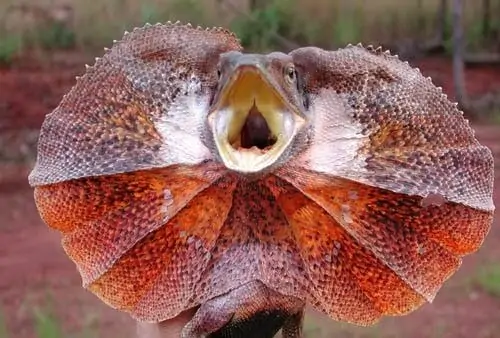
While this can take time, it’s definitely worth the effort.
To help your frilled dragon feel comfortable, place their enclosure on a stable surface so that they have a good elevated view of the room. Put them in a room where they can see you!
Once you’ve done this, these reptiles will spend time watching your every move. Just go about your day so they adjust and know what to expect from you.
When you’re feeding the lizard or cleaning the enclosure, don’t make any sudden movements. Speak to them in a comforting voice and be gentle. Over time, they will start investigating your hand.
Eventually, they will get comfortable enough to approach your hand. Then, they’ll start jumping on your hand every time you reach in!
At that point, you can rest easy knowing that your lizard trusts you enough for handling. Support their body and be gentle when handling then. Frilled dragons are known to get very comfortable with owners, so feel free to show them around your home and have fun!
Give Them A Shot!
We hope this care sheet has shown you just how amazing owning a frilled dragon can be. These reptiles are incredibly fun to handle and observe.
As you can see, frilled dragon care is also pretty straightforward too. No matter how much experience you have, you shouldn’t have any problems keeping this lizard as a pet!
If you have any lingering questions about this reptile we’re more than happy to help. Just reach out to us directly and we’ll respond as soon as we can!

